You will love this classic recipe for Strawberry Jam, made with ripe, aromatic strawberries at the height of their season. It contains just three ingredients – strawberries, sugar and lemon juice. No pectin is required for this delicious, soft set jam. This is the ultimate way to preserve the berries so that they can be enjoyed throughout the coming months.
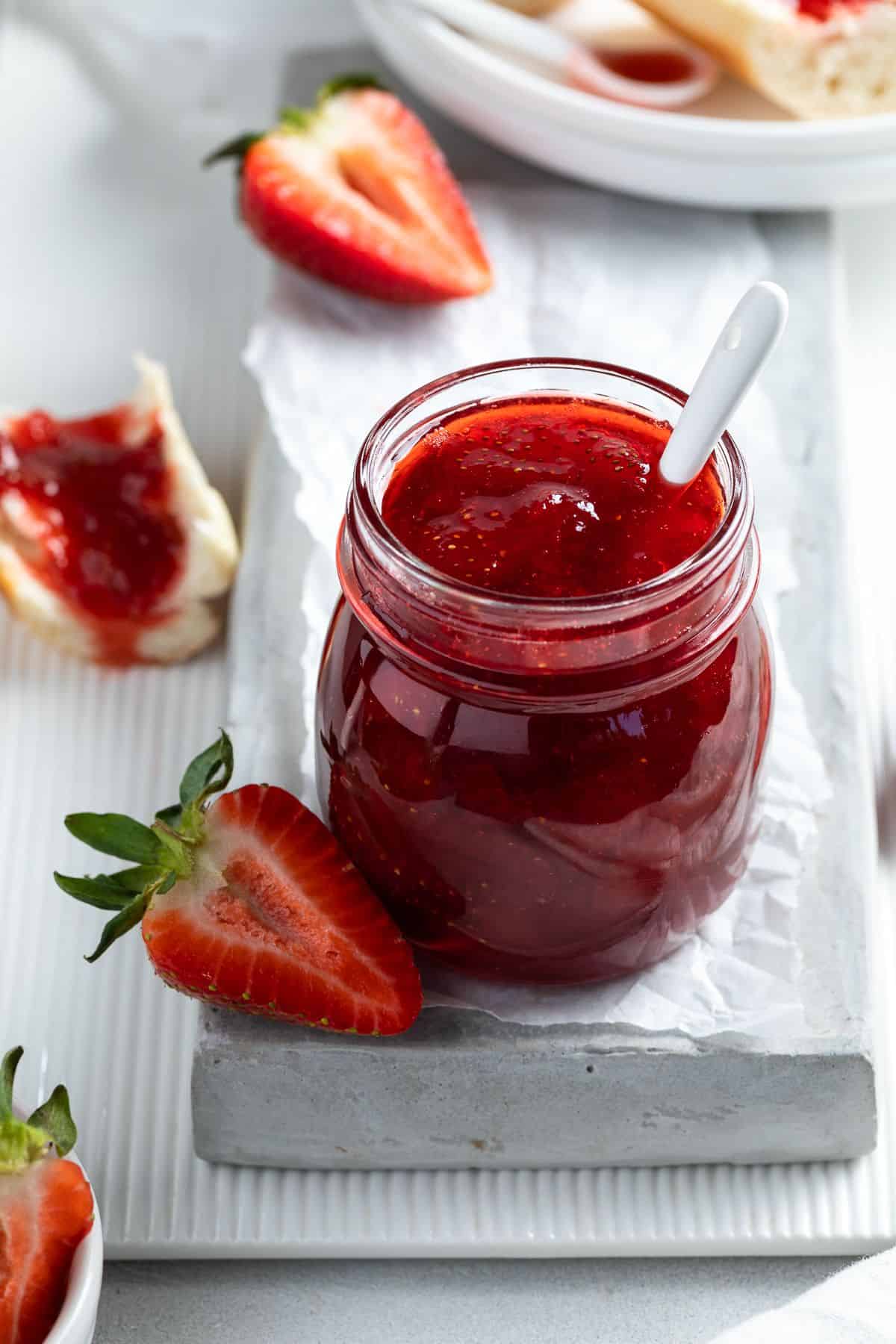
You’ll love this recipe for Strawberry Jam because:
- Jam making is a great way to preserve some of nature’s seasonal bounty to enjoy throughout the cooler months ahead – if it lasts that long.
- Homemade jam is infinitely superior to shop-bought. You will not find any unwelcome additives, artificial preservatives or thickeners that you may find in a commercially prepared Strawberry Jam. For me, one of the most important parts of home cooking is the knowledge that I control the quality of the ingredients.
- You can use this delicious Strawberry Jam in so many ways. Spread it on toast for breakfast, serve with scones and cream, make mini tarts, fill sponge cakes or drizzle over our No-Churn Vanilla Ice Cream. You are only limited by your imagination.
Ingredients in this recipe:
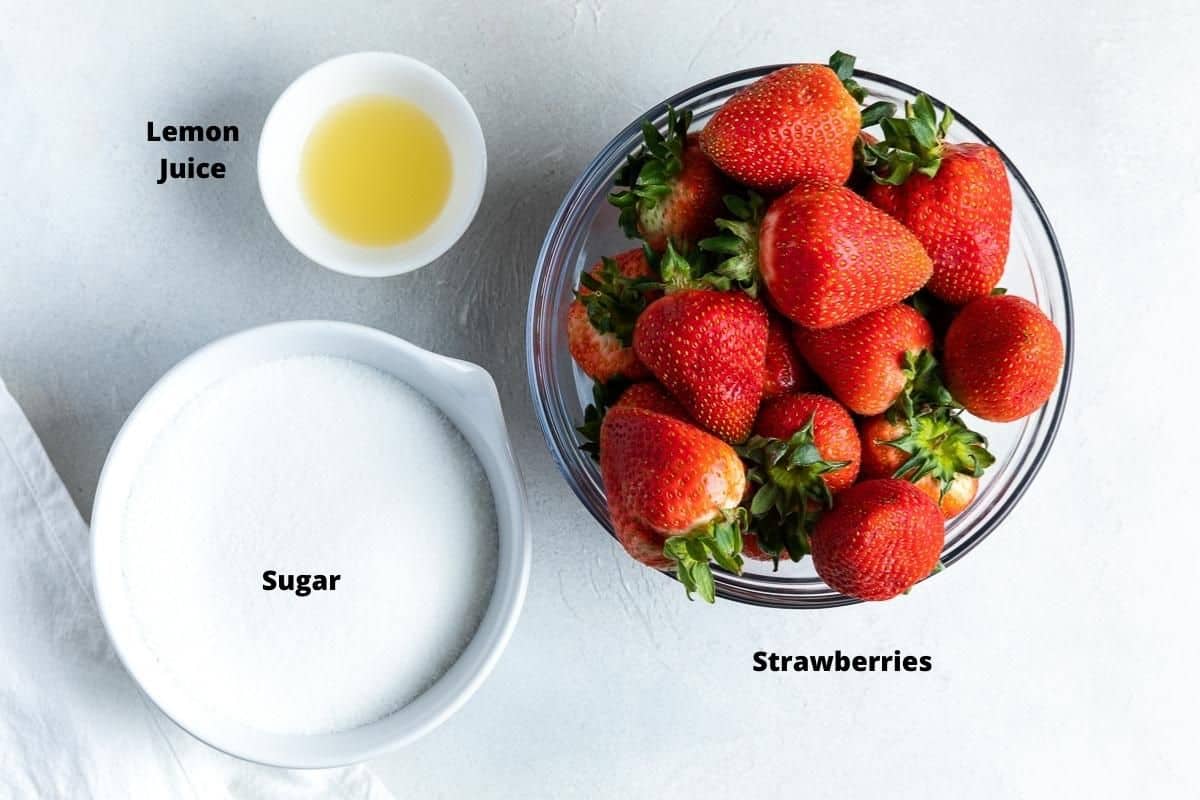
Please see the recipe card further along in the post for exact quantities of ingredients and the full method.
Strawberries – use fresh berries in good condition, ideally with some slightly unripe berries as they will contain more pectin.
Sugar – regular granulated sugar is best.
Lemon juice – use freshly squeezed lemon juice. The juice is vital, it aids in the setting of the jam.
How to Make Strawberry Jam:
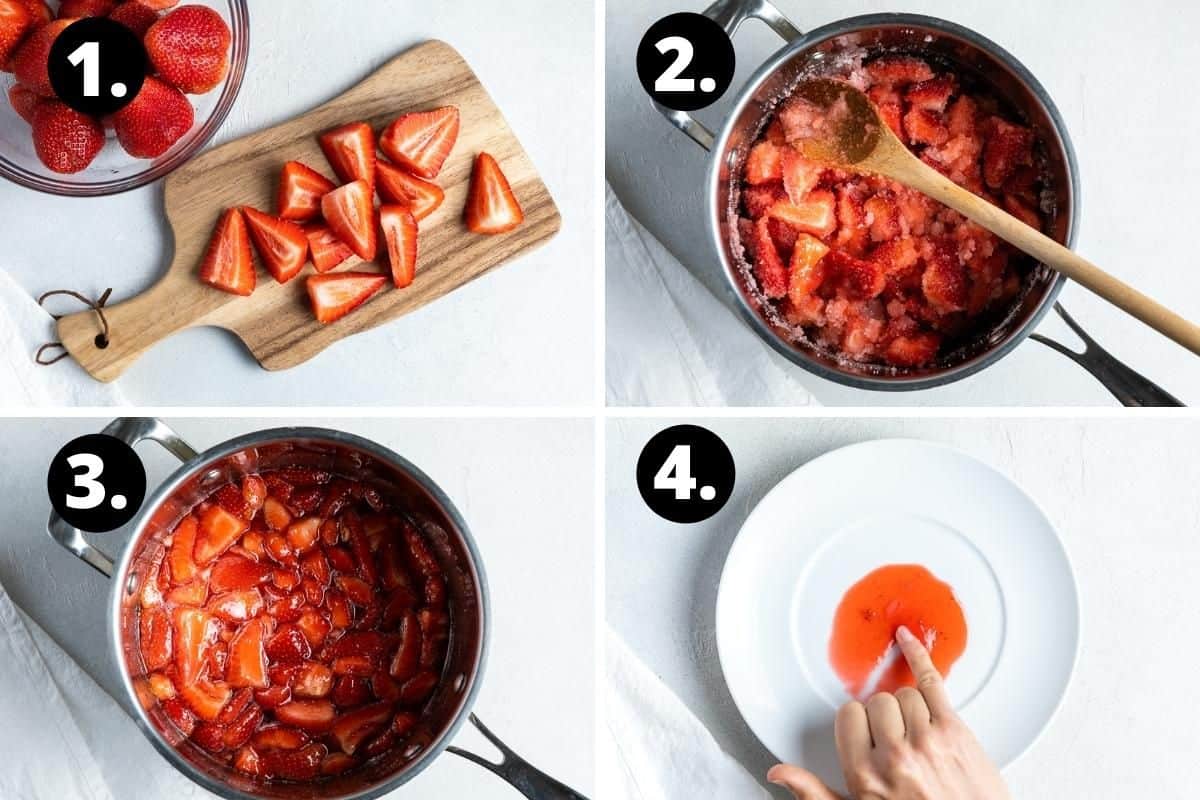
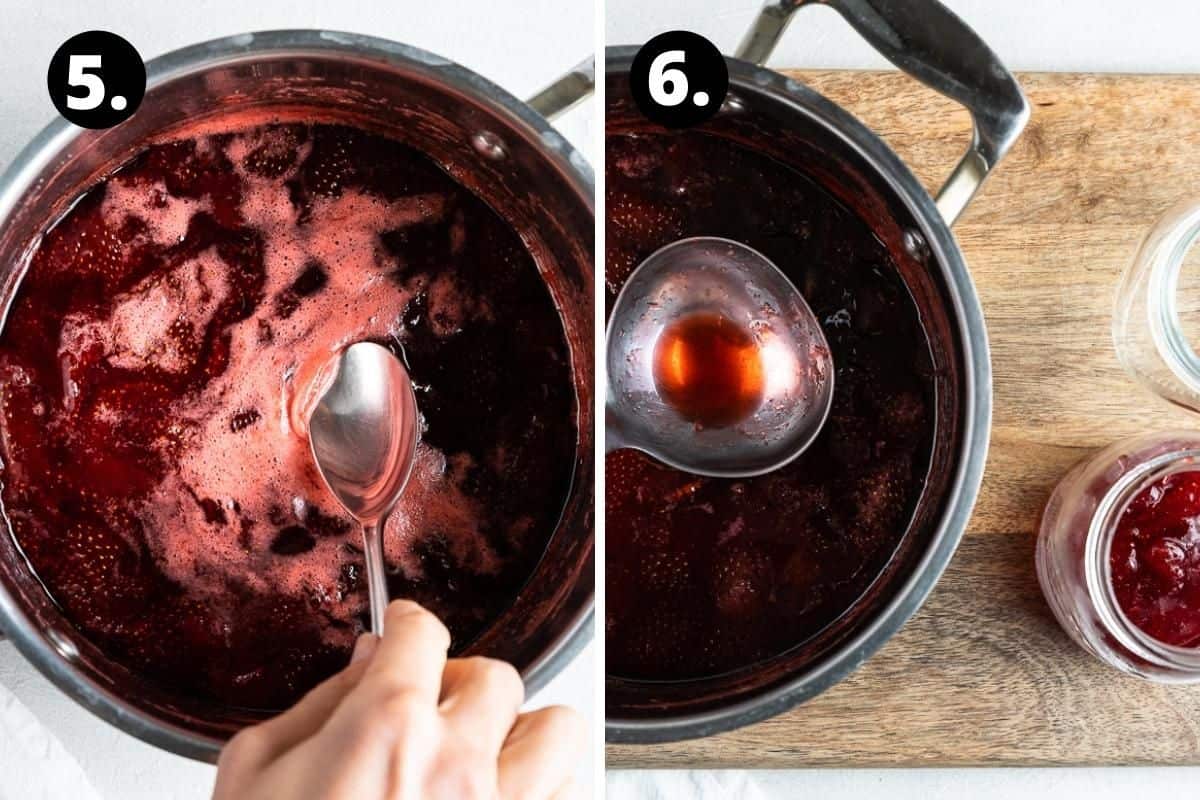
To begin, place two small saucers or plates in the freezer. You will use these to test when the jam is set.
Sterilise the jars by heating in the oven. Full directions are in the recipe below.
- Wash and thoroughly dry the strawberries, remove the green stem and cut the berry in half or quarters.
- Add the strawberries, sugar and lemon juice to a large saucepan and mix well with a wooden spoon.
- Turn the heat on low, stir until the sugar dissolves and then increase the heat to a rolling boil. Boil for 10 minutes stirring frequently.
- Turn off the heat and spoon a little of the jam onto a chilled saucer. Let it stand for 30 seconds to cool, then run your finger through it. If it wrinkles, it is ready. If it is still quite liquid, put it back on the heat and boil for a further 1-2 minutes, and retest.
- Allow the Strawberry Jam to sit for 10 minutes before carefully ladling into jars. This helps the chunks of fruit to disperse evenly throughout the jam. Remove any scum from the top of the jam with a clean spoon.
- Carefully ladle your jam into the hot jars and put the lids on to seal. After cooling, wipe the jars to remove any spills, and store in a cool, dark place.
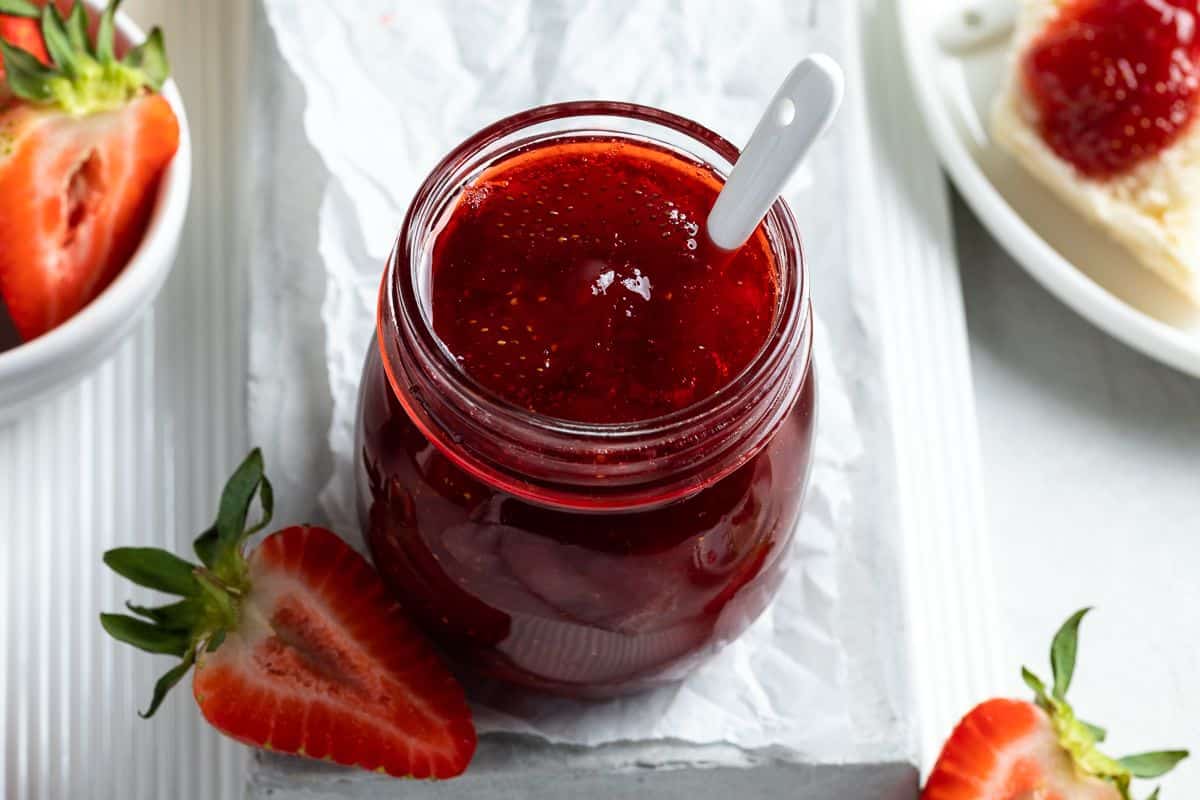
Tips for success and FAQs:
The selection of fruit is very important as strawberries are low in pectin which is essential to help the jam set. Most of the strawberries should be at their peak of ripeness. Do not use berries that are over-ripe, soft or bruised. They may cause the jam to spoil. Good quality fruit is essential to obtain the best flavour. Ideally, for maximum pectin, use fruit that is freshly picked. However, it is an advantage to have some which are slightly under-ripe as they will contain more pectin and acid, both of which assist with setting the jam. Your jam will only be as good as the fruit that you use.
When making your own preserves, always ensure you are sterilising the jars you will store them in. This is very simple to do:
- Choose glass jars with an airtight, metal lid and ensure they have been washed in the dishwasher or by hand in hot soapy water then rinsed well.
- Preheat the oven to 130 Degrees C (270 F) and leave the jars in the oven for 15-20 minutes.
You will not need any special equipment to make this recipe. You need a large, wide saucepan. The large surface area allows faster water evaporation, giving the jam a concentrated flavour. Without a large saucepan, there is the risk of it boiling over. Avoid aluminium, copper or iron pans; the acid in the fruit may react with the pan, giving the jam a metallic taste. As well, I use a long-handled wooden spoon to keep my hand away from the bubbling jam.
If you follow the recipe instructions precisely and your jars are thoroughly sterilised, the Strawberry Jam should be shelf-stable for a year, possibly longer. When you open a jar, store it in the fridge.
Conventional jam requires a lot of sugar. When you see it weighed out it is slightly alarming but please don’t reduce the amount of sugar. The sugar not only sweetens the fruit but it helps the jam to set and acts as a preservative. If you reduce the sugar, in short, your jam may not be shelf-stable.
Lemon plays an important role in jam-making. It is high in pectin. As strawberries are low in pectin the lemon juice provides the necessary boost to aid in setting the jam. Further, the acidity of the lemon helps balance the sweetness.
Pectin is a naturally occurring starch that is found in varying degrees in fruits and vegetables. It is what makes jams and jellies firm when they are cool. When combined with acid and sugar, and cooked to a high temperature, it forms a gel. In this recipe, I add a small amount of lemon juice to boost the pectin content.
You can use recycled glass jars with metal lids that are in good condition or purchase new ones. Jars which have contained pickles are generally not suitable as they often hold the aroma. Save these for your own chutneys or pickles.

More delicious recipes for you to try:
We love to make the most of seasonal produce. Making jams, preserves, pickles and condiments is a great way to enjoy them year-round. Here are some more of our favourite recipes:
- Fresh Peach Chutney
- Preserved Chillies in Oil
- Apricot Jam
- Lemon Marmalade
- Plum Jam
- Grapefruit Marmalade
- Blueberry Jam
- Raspberry Jam
- Blackberry Jam
My Easy Strawberry Jam recipe is a great place to start if this is your first time making jam. Once you’ve perfected your jam making technique you will have the ability and equipment to make fresh jam for years to come. You just need to invest a little of your time; when you finish and see your own produce lined up, you will know that it was time well spent.
I would love to hear from you when you have tried this delicious Strawberry Jam.
Alex xx
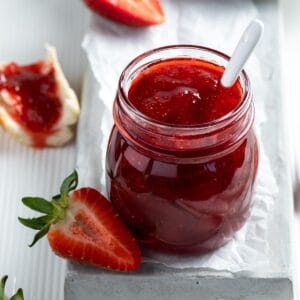
Strawberry Jam
Please note:
For accuracy, when weights are provided, we recommend weighing your ingredients. This will produce the best results. All oven temperatures listed are for fan forced.
Ingredients
- 600 g (21 oz) strawberries See Note 1
- 450 g (2 cups) sugar See Note 2
- 2 tablespoon (40 ml) lemon juice – freshly squeezed See Notes 3 and 4
Instructions
To Sterilise the Jars:
- Choose glass jars with an airtight, metal lid and ensure they have been washed in the dishwasher or by hand in hot soapy water then rinsed well.Preheat the oven to 130 C. Place upright jars and lids on a baking tray. Heat in the oven for at least 20 minutes, then remove and immediately fill with jam. See Note 5.
To make the Strawberry Jam:
- Place two small saucers or plates in the freezer. See Note 6.
- Wash and thoroughly dry strawberries. Remove the green stem from the strawberry and cut them in half. For larger strawberries, you may wish to quarter them. Add the strawberries, sugar and lemon juice to a large saucepan and mix well with a long-handled wooden spoon.
- Turn the heat on low and stir until the sugar dissolves. (This can take 5-8 minutes)If sugar crystals get caught on the side of the saucepan, scrape down with a spatula or wipe down with a pastry brush dipped in cold water. The sugar should be completely dissolved before bringing the jam to a boil, or the finished jam may crystallise.
- Once the sugar is dissolved, increase the heat to a rolling boil.Boil for 10 minutes, stirring frequently. After 10 minutes, begin to check for the setting point. Your jam will likely take between 10-12 minutes, but it will depend on the width of your saucepan and how rapidly the jam is boiling.
- Turn off heat and spoon a little of the jam onto one of your chilled saucers.Let it stand for 30 seconds to cool, and then run your finger through it. If it wrinkles, even slightly, it is ready. If it is still quite liquid, put it back on the heat and boil for a further 1-2 minutes, and retest until ready. Alternatively, you could use a candy thermometer. Setting point is reached when the thermometer reaches 105 Degrees C (220 F).
- Skim any scum off the top of the jam with a spoon.
- Allow the jam to sit for 5 minutes to allow the fruit to disperse evenly.
- Carefully ladle your jam into your hot jars and put the lids on immediately. Allow the jam to cool completely. Wipe the jars to remove any spills, and store the jam in a cool, dark place.
- If you follow the recipe instructions precisely and your jars are thoroughly sterilised, the Strawberry Jam should be shelf-stable for a year, possibly longer.
Notes
- Ensure your fruit is freshly picked and of good quality. Avoid fruit that is bruised or over-ripe. The older the fruit, the less pectin it will contain which may affect the jam setting.
- Do not reduce the amount of sugar. Whilst the sugar sweetens the fruit it also acts as a preservative and helps the jam to set. If you reduce the sugar, your jam may not be shelf-stable and may become mouldy.
- The Australian tablespoon is 20ml or 4 teaspoons. In many other countries, the tablespoon is 15ml or 3 teaspoons. Please adjust the measurement if necessary.
- Lemon juice not only balances the sweetness of the sugar, but it also contains acid and pectin which help to set the jam.
- Properly sterilising your jars is an essential process to remove bacteria that could cause your preserves to spoil. Wash the jars and lids either in the dishwasher or by hand in hot soapy water, and rinse well. Do not dry them with a tea towel. Place jars and lids on a baking tray. If you are using Kilner jars with rubber seals, be sure to remove the seals before placing the jars in the oven. The dry heat of the oven would damage the seals. Boil the seals separately in a saucepan for about 10 minutes. Heat the jars in the oven for at least 20 minutes. When your preserves are ready to bottle, use thick oven mitts or jar tongs to remove the jars. Do not place them on a cold surface as they may shatter. I place mine on a wooden chopping board which I cover with a tea towel. Always sterilise a few more jars than you think you will need. It is better to have too many jars than not enough.
- The chilled plates are used to quickly cool the jam when testing the setting point.
- Always choose a large, wide saucepan that has enough height to enable the jam to boil vigorously. More surface area means the liquid will evaporate faster; having sufficient height means you can boil the jam at a higher heat and maintain the fresh flavour of the strawberries. Avoid aluminium, copper or iron pans; the acid in the fruit may react with the pan, giving the jam a metallic taste.
- Do not use a metal spoon, it will become very hot. A long-handled wooden spoon is important to avoid being burnt by a splash from boiling jam.
- My jam reached its setting point about 10 minutes after it began to boil rapidly. Boiling time will vary depending on the size of your saucepan and the heat that you apply.
- If you prefer smooth jam, use an immersion blender carefully once you have taken the strawberry jam off the heat.
- If your finished jam has not set as much as you would like, don’t worry, it will still be delicious stirred into some plain yoghurt or served over our No-churn Vanilla Ice Cream. Or, if it is slightly over-set and is very firm, it will be a lovely accompaniment on a cheese board.
- Please note, the nutritional information is based on one whole jar. The nutritional information is an estimate only.
Nutrition Estimate:
Nutritional Disclaimer:
The nutritional information is an estimate only, and is derived from online calculators. For accurate results, we recommend calculating the nutritional information based on the ingredients and brands you use.


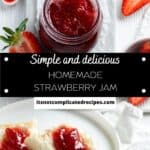


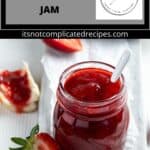
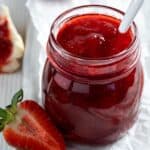
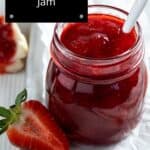



Anne
I made this jam after picking fresh strawberries and it was delicious. The lemon juice took away the sweetness so the flavour was just right.
Alexandra Cook
Thank you for trying this recipe, Anne!
I am so happy you enjoyed it 🙂 Alex xo
Gail maxey
absolutely delicious and very easy to do thank you 😊
Alexandra Cook
Hi Gail 🙂
Thank you so much. I am so pleased to hear that you enjoyed this recipe.
Alex xo
Lori Murphy
So good and very easy my family loves it
Alexandra Cook
Thank you so much, Lori!
Alex xo
Danielle E Jackson
Hi Alex, I made your stawberry and blackberry jams yesterday,and just tried them both today. OMG such an easy recipe with wonderful results. The taste of the strawberry jam, tasted like strawberries. The blackberry jam was exactly the same. This recipe, is going in the vault. Thank you Alex so much.
Alexandra Cook
Hello Danielle! 🙂
So lovely to read your comment – I am so pleased that you enjoyed both the Strawberry and Blackberry Jams, and I thank you for taking the time to let me know! Alex xo
Vicci Schooler
Are you able to use fresh strawberries but that have been frozen?
Alexandra Cook
You sure can, Vicci 🙂
Hope you’ll enjoy this recipe!
Ana
I’ve used this recipe twice now and I love it, it’s great for beginners. I added lemon zest and some sliced lemon to the second batch to counter the sweetness a little bit. Thank you for the recipe! 🙂
Alexandra Cook
Thank you so much, Ana 🙂
Appreciate you sharing your feedback. Alex xo
Denver
This turned out great! My biggest complaint is the sweetness. It’s extremely sweet! I read where you suggested not to cut back on the sugar so I wonder if I should add more than 21 oz of berries next time? This recipe made 2 pint jars then a half pint jar. So 2 cups of sugar went into 2.5 pints. That’s a lot!!
Other mentionables is the size of your pot. It needs to be bigger than you think because the foam boils up so much and it will overflow. Also, when wiping off the jar rims after you’ve poured in the jam, make sure you wipe it with a WET paper towel or cloth. Otherwise the fibers will stick to the sticky rim and your jars won’t seal.
All in all, I would def make this again because it’s a great method when you don’t want to use a water bath. Both my jars sealed within 20 min. I would like to figure out how to make this less sweet without compromising the pectin.
Alexandra Cook
Hi Denver,
I am so pleased that you enjoyed the Strawberry Jam.
For the jam to remain shelf stable, it is necessary to maintain the ratio of fruit to sugar – including if you were to increase the fruit. If you would prefer to reduce the sugar, this will effect how long the jam will last for, and it may be necessary for you to store it in the fridge.
Kind regards, Alex
Morgan Kenley
I made the raspberry jam from this page and that was delicious. Looking to try this too. Could frozen strawberries be used for this recipe? Looking to make a large volume as gifts. Thanks.
Alexandra Cook
Hi Morgan!
That is great to hear about the Raspberry Jam 🙂
Yes, frozen berries can be used. I use the best quality I can source and start cooking them straight from frozen. Let me know how you get on! Thanks, Alex
Katie
This is such a great trouble shooting post! I haven’t made jam in years but you inspired me, and it turned out perfectly!
Alexandra Cook
Thrilled to hear this, Katie! Thanks so much for taking the time to let me know 🙂
Susan
This is a FANTASTIC strawberry jam recipe if your looking for a perfectly textured, simply flavored, classic strawberry jam. It turned out on the first try for me- I followed directions exactly. Since then, I have made two more times and it’s just been really tasty each time. Thanks!
Alexandra
Hi Susan, I am delighted to hear that you enjoyed the Strawberry Jam and have made it several times. Thank you for taking the time to let me know. 🙂
Julia
We loved making this strawberry jam!:) Thanks!
Alexandra
Hi Julia, I am delighted to hear that you enjoyed making the Strawberry Jam. Thank you for letting me know. 🙂